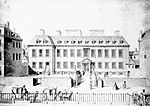Chinatown, London
Areas of LondonChinatown, LondonChinatowns in EuropeChinese community in the United KingdomCity of Westminster ... and 5 more
Districts of the City of WestminsterEngvarB from June 2013Ethnic enclaves in the United KingdomSoho, LondonWikipedia indefinitely semi-protected pages

Chinatown is an ethnic enclave in the City of Westminster, London, bordering Soho to its north and west, Theatreland to the south and east. The enclave currently occupies the area in and around Gerrard Street. It contains a number of Chinese restaurants, bakeries, supermarkets, souvenir shops, and other Chinese-run businesses. The first Chinatown was located in Limehouse in the East End.
Excerpt from the Wikipedia article Chinatown, London (License: CC BY-SA 3.0, Authors, Images).Chinatown, London
Leicester Street, London Chinatown
Geographical coordinates (GPS) Address Nearby Places Show on map
Geographical coordinates (GPS)
| Latitude | Longitude |
|---|---|
| N 51.511111111111 ° | E -0.13138888888889 ° |
Address
Joy King Lau
Leicester Street 3
WC2H 7BL London, Chinatown
England, United Kingdom
Open on Google Maps







